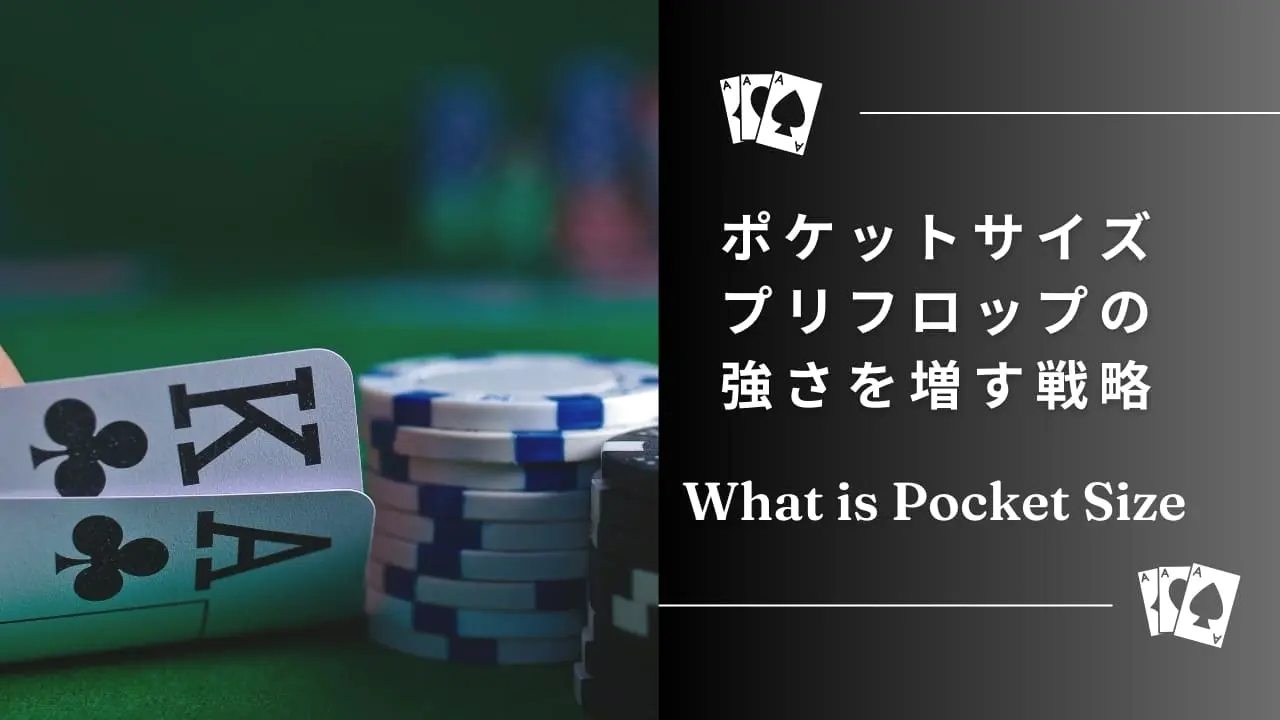Have you ever heard the term “pocket size” in poker? This phrase is used to describe a pocket pair—when your two hole cards are of the same rank. The larger the pocket size, the stronger your hand is preflop, making it a crucial element in poker strategy.
In this article, we’ll dive deep into the meaning of pocket size, the differences in strength, and optimal playing strategies for each pocket size. It’s packed with insights useful for both beginners and advanced players.
What Does Pocket Size Mean in Poker?
Pocket size refers to the ranking strength of a pocket pair. A pocket pair means both of your hole cards are of the same rank. Pocket size generally indicates how strong that pair is, and it is commonly categorized as follows:
Basically, the higher the pocket size, the stronger your hand is preflop, and the more aggressively you can play. However, mishandling a pocket pair can lead to major losses—so understanding the right strategies is critical.
| Pocket Size | Example of Hand | hand strength |
| pocket size A | AA | Best pocket pair |
| pocket size K | KK | pretty strong hand |
| pocket size Q | Powerful but requires caution | |
| pocket size J | JJ | Mid to high pocket pair |
| pocket size 8 | 88 | medium strength |
| pocket size 5 | 55 | low middle pair |
| pocket size 2 | 22 | The weakest pocket pair |
Playing Strategies Based on Pocket Size
1. High Pocket Pairs (AA, KK, QQ)
High pocket pairs are very powerful hands preflop and should generally be played aggressively. Especially AA and KK are among the strongest starting hands and merit heavy chip investment.
Strategy:
- Aim for aggressive raises, 3-bets, and even 4-bets preflop
- Keep betting post-flop to apply pressure
- Play cautiously if the flop is dangerous (like potential straights or flushes)
Example:
If you’re holding AA preflop, an open raise is a must. If your opponent 3-bets, go for a 4-bet and consider going all-in.
2. Middle Pocket Pairs (JJ, TT, 99, 88, 77)
These are strong hands but become risky when overcards (higher than your pair) appear on the board. TT and JJ, for example, are vulnerable to higher pairs or hands like AK.
Strategy:
- Preflop raises and occasional 3-bets are effective
- If overcards show on the flop, consider checking or folding
- Watch your opponent’s bet sizes and actions closely
Example:
Holding TT and the flop comes A-K-7. If your opponent bets aggressively, folding might be the best option.
3. Low Pocket Pairs (66, 55, 44, 33, 22)
Low pocket pairs are typically played to hit a set (three of a kind). They’re not strong preflop, so you need to proceed carefully based on your opponent’s actions.
Strategy:
- If the preflop raise is small, call and try to hit a set (set mining)
- If you miss the set, don’t force the action
- If you hit a set, aim for a big pot (check-raise, etc.)
Example:
Holding 55 and the flop comes 5-9-K — you’ve hit a set and can aim for a big pot depending on your opponent’s actions.
Tips for Playing According to Pocket Size: Core Principles
Your playing style should change depending on the size of your pocket pair. Here are the basics:
1. High Pocket Pairs (AA, KK, QQ)
Top-tier hands that should be played aggressively.
Preflop Strategy:
- Open raise is a must (to reduce the number of opponents)
- If re-raised, go for a 3-bet or 4-bet
- Don’t hesitate to go all-in when appropriate
Postflop Strategy:
- If you have an overpair on the flop (e.g., holding KK on a Q-7-3 flop), keep betting
- Be cautious on draw-heavy boards (straight or flush potential)
Caution:
- Be careful when an Ace appears and you’re holding KK or QQ
- Use slowplay carefully—it can backfire
2. Middle Pocket Pairs (JJ, TT, 99, 88, 77)
Strong hands, but beware of overcards.
Preflop Strategy:
- Raise or 3-bet depending on your opponent’s style
- Against fish (beginners) or aggressive players, strong play is effective
Postflop Strategy:
- If overcards like A, K, or Q appear, proceed with caution
- If the flop is under your pair (e.g., holding 99 on an 8-5-2 board), consider continuation betting
Caution:
- In multiway pots (3+ players), play more cautiously
- For pairs lower than 99, don’t challenge strong actions without a solid reason
3. Low Pocket Pairs (66, 55, 44, 33, 22)
Generally played with the goal of hitting a set.
Preflop Strategy:
- Evaluate whether to call or fold based on the opponent’s raise size
- Main goal is set mining
- Avoid going all-in if facing a 3-bet
Postflop Strategy:
- If you hit a set, bet aggressively (slowplay can work as a trap)
- If not, consider folding rather than forcing the play
Caution:
- If the preflop raise is too high, don’t call with low pairs
- Even with a set, beware of flush and straight draws
Advanced Tips for Using Pocket Size Effectively
1. Bigger Pocket Size = More Aggression
Hands like AA, KK, and QQ should be played assertively from the preflop stage. Especially AA and KK have great potential for big pots—even all-ins.
Don’t Do This:
Limping (just calling) with AA or KK — it gives opponents a cheap shot at a stronger hand.
2. Be Cautious with Mid & Low Pairs Based on the Board
Mid and low pairs change in strength depending on the board. For instance, if you have 99 and the flop is K-J-5, you should consider the likelihood your opponent holds K or J.
3. Avoid Risky Calls with Low Pocket Pairs When Set Mining Isn’t Profitable
Play low pairs mainly to hit a set. But set mining is only worthwhile if the preflop raise is small.
Don’t Do This:
Calling large raises with low pairs
Continuing after missing the set on the flop
4. Don’t Let Opponents See the Flop Cheap with Strong Pocket Pairs
If you’re holding AA or KK, you shouldn’t let opponents see the flop for free. Overusing slowplay gives them opportunities to complete straights or flushes.
5. Always Consider Table Position (BTN, CO, HJ, etc.)
Your position at the table impacts the value of your pocket pair.
- From late position (BTN, CO), play pocket pairs more aggressively
- From early position (UTG, MP), play middle and low pairs with caution
Conclusion
Pocket size is a key indicator of the strength of your pocket pair and plays a major role in poker strategy.
- High Pocket Pairs (AA, KK, QQ): Play aggressively
- Middle Pocket Pairs (JJ, TT, 99, 88, 77): Play with caution
- Low Pocket Pairs (66, 55, 44, 33, 22): Play primarily to hit sets


